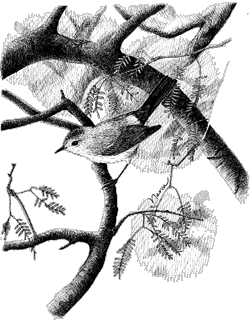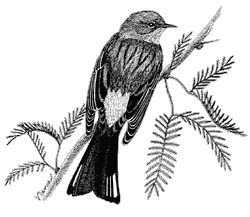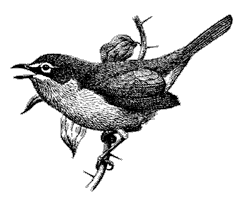Wood Warblers
Often referred to as the “butterflies of the bird world,” wood warblers are very small, active, and colorful. They flit through the foliage from the treetops to the understory in search of small insects. More than fifty species occur in North America; almost all are migratory, and many spend the summer in northern coniferous forest and the winter in tropical rainforest.
 |
Since these birds are lovers of trees and foliage, it is not surprising that the warbler family is under- represented in the desert. A few species, like the Yellow Warbler and the Yellow-breasted Chat, spend the summer in the dense habitats along southwestern rivers. In winter, Orange-crowned Warblers may forage quietly in the undergrowth of those same riparian thickets. Yellow-rumped Warblers, hardy little birds that arrive to spend the winter throughout the lowlands of the Southwest, are sometimes common along rivers and in dense mesquite bosques in the desert. Several other warbler species may stop through in migration. There are times in late spring and early fall when bright golden- yellow Wilson’s Warblers seem to flit along every wash in the desert.
Of all this diverse family the only species truly adapted to the desert is Lucy’s Warbler, a pallid gray-and-white sprite with touches of chestnut in the plumage. Lucy’s Warblers arrive from Mexico quite early in spring, and soon the bright, simple songs of the males can be heard everywhere among the mesquite trees.
—Kenn KaufmanWood Warblers
Representative Sonoran Desert species
Orange-crowned Warbler (Vermivora celata)
Yellow-rumped Warbler (Dendroica coronata)
Wilson’s Warbler (Wilsonia pusilla)
Yellow Warbler (Dendroica petechia)
Yellow-breasted Chat (Icteria virens)
Lucy’s Warbler (Vermivora luciae)
Order: Passeriformes
Family: Parulidae (Wood-Warblers)
Spanish names: gusanero, chipe
Distinguishing Features
Orange-crowned Warbler: Olive-green upperparts, orange crown patch (rarely visible), olive-yellow underparts, broken eye ring, no wing bars; lack of conspicuous markings is a good aid in identification.
 |
Yellow-rumped Warbler male: bright yellow cap, throat and rump, broken eye ring, yellow patch at side of breast, white underparts; female: similar but duller, yellow on throat less distinct.
Wilson’s Warbler: Yellow head and underparts, olive upperparts, males have distinct black cap. Yellow Warbler: Overall yellow plumage, upperparts greenish-yellow.
Yellow-breasted Chat: The largest warbler, distinct white eye rings, bright yellow throat and breast, olive-brown upperparts, thick bill.
Lucy’s Warbler: White below, pale gray above, pale face with suggestion of eye-ring; reddish brown spot on crown and patch on rump, more obvious on adult male.
Habitat
Orange-crowned Warbler prefers riverside or shrubby vegetation, chaparral, gardens, and parks. Yellow-rumped Warbler inhabits streamside woodland in our region. Wilson’s Warbler frequents thickets along streams, scrubby clearings, moist tangles. Yellow Warbler is found in streamside habitats, especially cottonwood-willow groves in our region. Yellow-breasted Chat frequents streamside thickets, meadows with tall shrubs, woodland edges. Lucy’s Warbler prefers mesquite bosques and edges of riparian woods in desert zones.
Feeding
• Diet: The Yellow, Wilson’s and Lucy’s Warblers feed almost entirely on insects; the other species feed primarily on insects but also eat some berries.
• Behavior: It is not uncommon for two or more species of warblers to exist in the same habitat and feed on the same kinds of insects. They cope with competitive pressure by foraging in slightly different ways. Orange-crowned Warbler forages by flitting from branch to branch or hovering in search of insects on foliage; will also take insects midair.
Yellow-rumped Warbler forages by hovering and taking insects from foliage, taking insects midair, searching among twigs, and searching through ground litter.
Wilson’s Warbler forages by hopping about on branches, tree trunks, and on the ground; also catches insects midair. Yellow Warbler behavior is similar to Orange-crowned Warbler.
 |
Yellow-breasted Chat forages by moving about in dense vegetation; perches to eat berries; unlike other warblers it holds its food in one foot while eating. Lucy’s Warbler hops about actively in trees and shrubs, seeking insects on the twigs and foliage.
Life History
These tiny, colorful, active birds are found only in the New World. Many tropical warblers are not migratory. All of ours are, but they occur here at different seasons. Orange-crowned is present mostly September to May, and Yellow-rumped mainly October to April (they winter here). Wilson’s, a migrant, occurs in Spring and Fall. Lucy’s and Yellow Warblers nest here, and are present mainly March to September; Yellow-breasted Chat also nests, and is present mainly May to September.
In spite of their name, warblers are not particularly well known for the musicality of their voices. The exception, however, is the Yellow-breasted Chat. Its song consists of an odd assortment of whistles, chucks and hoots.
Most warbler nests are open cups made of leaves, twigs, weeds, and other vegetable matter with a lining of finer material. Wilson’s and Orange-crowned Warbler nests are on the ground; the others make their nests in forks or on horizontal branches of trees and shrubs. Lucy’s Warbler is one of only two members of the family to nest in holes in trees; it also sometimes builds its nest behind a piece of loose bark. The female is usually responsible for both nest building and incubation. The female lays 3 to 6 eggs that are usually white with brownish spots. Incubation with these species ranges from 10 to 13 days. Both parents feed the young. The young leave the nest 8 to 13 days after hatching.
The Wilson’s Warbler, Yellow Warbler, and Yellow-breasted Chat are frequently parasitized by cowbirds. When this happens to the Yellow Warbler it may either build a new nest on top of the cowbird eggs or abandon the nest altogether.










